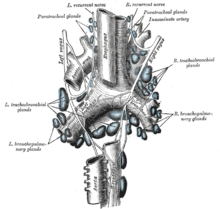Recurrent laryngeal nerve
The recurrent laryngeal nerve ( dt. Retrograde larynx nerve , vocal nerve ) is a branch of the tenth cranial nerve , the vagus nerve .
description
It separates from the vagus at the level of the upper thoracic aperture (chest entrance), describes a loop around the aortic arch on the left and the subclavian artery on the right, and pulls the trachea back to the larynx , where it gives off some branches to supply the esophagus and trachea. The remaining section close to the larynx is now called the caudal laryngeal nerve in animals and the inferior laryngeal nerve in humans . It supplies all larynx muscles with the exception of the cricothyroid muscle , which is innervated by the upper laryngeal nerve. In the piriform recess there is a connection between the two larynx nerves known as the Galen anastomosis .
The conspicuous course of the recurrent laryngeal nerve results from complex ontogenetic processes and is directly caused by the so-called descent of the heart in the embryo. Interpreted phylogenetically , the recurrent laryngeal nerve is originally the sixth gill arch nerve. Its strange-looking course is historically interpreted with reference to the topology of structures rated as homologous and is said to have resulted from the reshaping of the so-called gill arches.
Damage to the nerve

Unilateral damage to the recurrent laryngeal nerve - e.g. B. mechanical damage during neck operations ( thyroid removal ), inflammation in its environment or the nerves themselves - lead to paralysis or paresis of the vocal cords ( recurrent palsy ) and thus to a hoarse voice . Damage on both sides also leads to severe shortness of breath, as the glottis, which is not opened wide enough, hinders breathing.
- Veterinary aspects
In animals (especially horses ) paralysis of the left recurrent laryngeal nerve is relatively common and a lack of assurance . They lead to a one-sided larynx paralysis, which is also known as larynx whistling .
variety
A deviating course of this nerve without a loop around the right subclavian artery, in which the nerve takes a largely straight course, is rare. With this variety, there is an increased risk of injury in the context of thyroid operations and especially when the parathyroid glands are surgically removed . It is usually associated with the variety of a lusoria artery , which can be detected in three-dimensional thin-slice computed tomography to prevent nerve damage prior to parathyroid surgery.
Evidence for Evolution
The extremely long detour that the nerve makes through the body (the length of the giraffe is almost 5 meters) is cited by evolutionary biologists as evidence of evolution. With a “constructed living being” it would have made no sense to choose such a long course. The nerve has reached this length because, in the course of evolution, the neck has become longer and the heart has moved deeper into the body.
swell
- Michael Schünke , Erik Schulte , Udo Schumacher : Prometheus. Learning atlas. Head, Neck and Neuroanatomy . 4th edition. Thieme, Stuttgart 2015, ISBN 978-3-13-139544-3 , p. 215 .
Individual evidence
- ↑ Jacopo D'Agostino, Michelle Diana, Michel Vix, Luc Soler, Jacques Marescaux: Three-Dimensional Virtual Neck Exploration before Parathyroidectomy . New England Journal of Medicine 2012; Volume 367, Issue 11 of September 13, 2012, pp. 1072-1073
- ↑ Mammal Anatomy: An Illustrated Guide . Marshall Cavendish Corporation, 2010, ISBN 0-7614-7882-5 , pp. 74-75.
- ^ Richard Dawkins : 11. History written all over us . In: The greatest show on Earth . Free Press, New York 2009, ISBN 978-1-4165-9478-9 , pp. 360-362 (accessed November 21, 2009).

